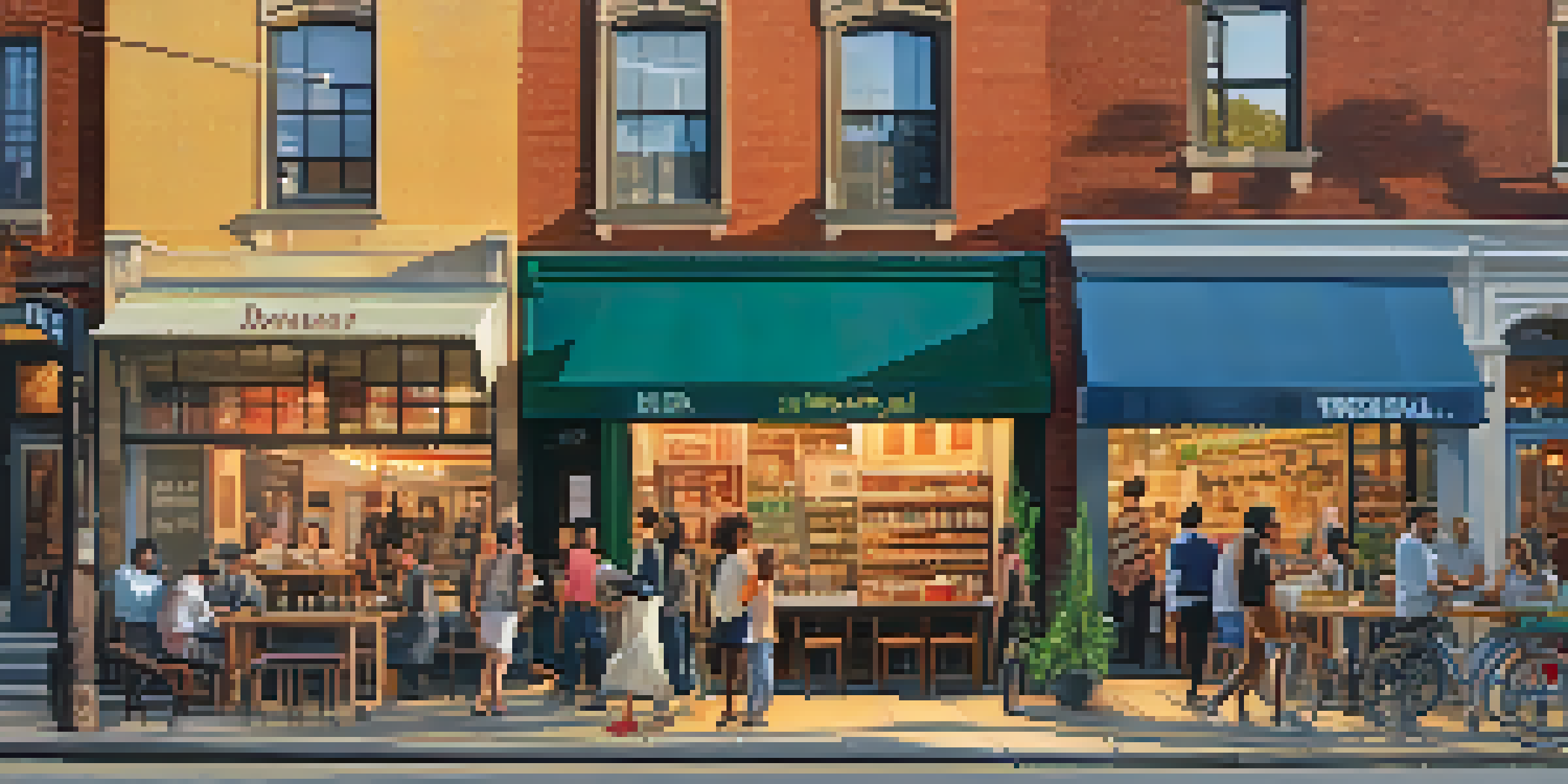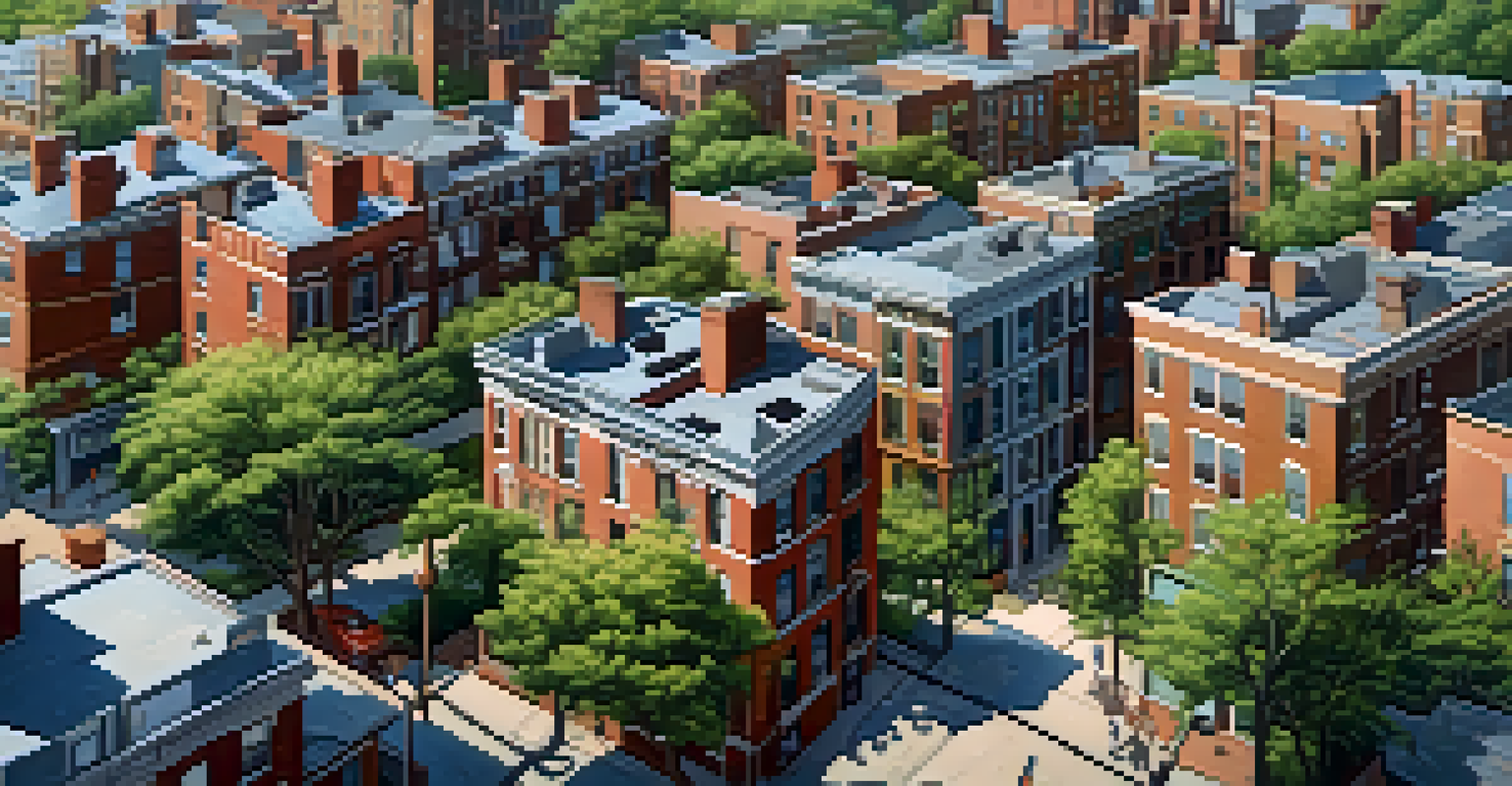Understanding Gentrification: Its Impact on NYC Neighborhoods

What is Gentrification and Why Does It Matter?
Gentrification is a term that describes the transformation of neighborhoods through an influx of new, often more affluent residents. This change can lead to rising property values and shifts in the local economy. While some view it as a positive development that revitalizes areas, others see it as a threat to the cultural fabric and affordability of communities.
Gentrification is a complex process that brings both opportunities and challenges to neighborhoods.
At its core, gentrification involves a delicate balance between improvement and displacement. Many long-time residents may find themselves unable to afford rising rents, leading to a loss of community identity. This phenomenon isn't just a New York City issue; it’s happening in urban areas across the globe, making it a topic of significant concern.
Understanding gentrification is crucial for both local governments and residents, as it shapes the future of cities. It's not just about new coffee shops and trendy boutiques; it’s about the people who call these neighborhoods home and the diversity that makes them vibrant.
Historical Context: Gentrification in NYC
To fully grasp gentrification in New York City, it’s essential to consider its historical context. Post-World War II, many neighborhoods experienced significant decline due to various factors, including economic shifts and the rise of suburban living. However, the late 20th century saw a resurgence of interest in urban living, leading to the gentrification process we witness today.

Areas like Harlem, Williamsburg, and the Lower East Side have undergone dramatic transformations, attracting new residents and investments. This historical perspective highlights how gentrification often follows cycles of neglect and rebirth, making it a complex issue deeply rooted in urban development patterns.
Gentrification Balances Change and Displacement
Gentrification transforms neighborhoods, often leading to improved local economies while risking the displacement of long-time residents.
Each wave of gentrification brings its own set of challenges and opportunities, affecting the demographics and character of neighborhoods. By understanding the past, we can better navigate the present and future of these evolving spaces.
Economic Impacts of Gentrification
Gentrification often brings economic benefits, such as increased investment in infrastructure and local businesses. New residents typically have higher disposable incomes, which can support local shops and services. This influx can lead to job creation and overall economic growth in the area, making it an appealing prospect for city planners.
The neighborhood is not just a place to live; it’s a community, a culture, and a history that deserves to be preserved.
However, the economic rise can come at a cost. Long-term residents may struggle with higher rents and property taxes, forcing them to leave the neighborhoods they've called home for years. This conflict between prosperity and displacement raises critical questions about equitable growth.
Balancing these economic impacts requires thoughtful policy decisions that prioritize both development and the needs of existing residents. By fostering inclusive growth, cities can harness the benefits of gentrification while minimizing its negative consequences.
Social Changes: Who Benefits and Who Loses?
One of the most profound effects of gentrification is the social change it brings to neighborhoods. New residents often have different lifestyles, priorities, and spending habits, which can shift the cultural landscape of an area. This change can create a vibrant mix of communities, but it can also lead to tensions between newcomers and long-time residents.
As local businesses cater to an affluent clientele, traditional shops may close, and longstanding community events might be replaced with new, upscale offerings. This shift can lead to feelings of alienation among those who have lived in the area for generations, as their voices may be drowned out in the new narrative.
Cultural Shifts Reshape Community Identity
As new residents move in, they can alter the cultural landscape, which may overshadow existing traditions and heritage.
Ultimately, understanding who benefits and who loses in this process is vital for fostering a sense of community. Engaging all stakeholders in conversations about neighborhood changes can help bridge gaps and promote a more inclusive environment.
Cultural Shifts: The Changing Identity of Neighborhoods
Gentrification often leads to significant cultural shifts in neighborhoods, impacting everything from art to cuisine. As new residents move in, they bring their tastes and preferences, which can sometimes overshadow the existing cultural identity. This transformation can be both exciting and disheartening, as vibrant art scenes and culinary traditions may evolve or fade away.
For instance, areas like Brooklyn have seen a surge in art galleries and trendy eateries, changing the landscape of local culture. While this can attract tourists and new residents, it can also alienate those who feel their heritage is being overshadowed.
Preserving cultural identity amidst change is a challenge for many communities. Encouraging collaboration between old and new residents can lead to a richer, more diverse cultural tapestry that honors the past while embracing the future.
Policy Solutions to Mitigate Negative Effects
Addressing the challenges of gentrification requires proactive policy solutions that prioritize affordability and inclusivity. Local governments can implement measures such as rent control, affordable housing developments, and community land trusts to help maintain diversity in neighborhoods. These strategies are designed to protect long-time residents while still allowing for development.
Additionally, policies that promote small business support can help ensure that local entrepreneurs thrive amidst changing demographics. By providing resources and funding for community projects, cities can foster resilience and adaptability.
Community Engagement Drives Inclusive Growth
Active participation of residents is essential for ensuring that neighborhood development reflects their needs and preserves community values.
Ultimately, effective policy solutions must involve collaboration between residents, community organizations, and government officials. Engaging diverse voices in the decision-making process can lead to more equitable outcomes and a stronger sense of community.
Community Engagement: The Role of Residents
Residents play a crucial role in shaping the future of their neighborhoods, especially in the context of gentrification. Community engagement initiatives can empower locals to voice their needs and concerns, ensuring that development reflects their values. From town hall meetings to neighborhood councils, these platforms allow for meaningful dialogue and collaboration.
In many cases, grassroots movements have successfully advocated for policies that protect existing residents and promote community interests. By organizing and uniting, residents can influence local governance and hold decision-makers accountable for the impacts of gentrification.

Engaging residents not only fosters a sense of ownership but also cultivates a shared vision for the future. When communities come together to address challenges, they can create inclusive spaces where everyone feels welcome.